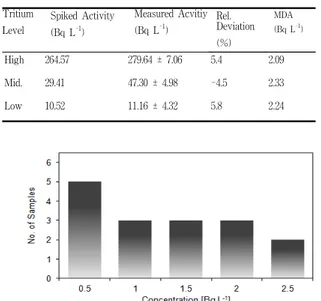2011년도 추계학술발표회 논문요약집 대한방사선방어학회
266_http://www.karp.or.kr
Measurement of tritium background level in urine of general
public
Seokwon Yoon, Wi-Ho Ha, Jaeryong Yoo, Seyoung Park, Min-Jeong Pak, Seung-Sook Lee
Korea Institute of Radiological & Medical Sciences National Radiation Emergency Medical Center
E-mail: ysw@kirams.re.kr Key words : 3H, Urine sample, General public
Introduction
Tritium is a pure beta particle emitter with a maximum energy of 18.6 keV (mean energy 5.7 keV) and has a physical half-life of 12.3 years. It can be found in nature due to the interaction with cosmic rays in the atmospheric gases and atmos-pheric nuclear weapon test carried out in the past years. In addition, it is mainly produced by hu-man activities such as heavy water-moderated reactors, nuclear fusion techniques and so on.
There are various intake routes to human body of tritium (inhalation, skin or ingestion of food and water), but its principal route is ingestion with a form of organically bound tritium (OBT) through diet. Once intake into the human body, it is uniformly distributed in the body fluid, and readily binding to hydroxyl radicals and forming tritiated water (HTO). Its biological half-life is 9.5 ± 4.1 days [1].
It is generally known that tritium is nontoxic isotope but chronical exposure to tritium source can cause critical damage to human health. For this reason, urine analysis for the workers of nu-clear power plant is periodically managed in the viewpoint of radiation protection. However, when the accident is breaking out, it is difficult to es-tablish an appropriate response plan due to the insufficient background study of tritium level of
general public.
In this study, we determined the background tritium level of urine samples from public and es-timated annual effective dose briefly, and per-formed the verification process of measurement method for the reliability of data.
Materials and Methods
Urine analysis is an important tool to determine the contamination level of casualties in radio-logical emergency. Because tritium activity has the characteristic of being in equilibrium with body fluid in 2 ~ 4 hrs after intake and the dose contribution of OBT is low, HTO in urine sample was used to determine tritium activity of body water [2].
18 urine samples from participants were analyzed. The age of participants ranged from 18 to 66 and 12 participants were male. As pre-viously mentioned, the analysis of a single urine sample was used to measure the activity at the time the sample was collected.
The measurement was performed using liquid scintillation counter (LSC, Quautulus, Perkin Elmer Co.). 2 distillation steps with KMnO4 and
Na2O2 were performed to remove the interference
materials, chemicals and color quenching substances. After the distillation it was mixed
2011년도 추계학술발표회 논문요약집 대한방사선방어학회
제6분과(측정 및 분석)_ 267
with cocktail (Ultima Gold LLT, Perkin Elmer Co.) in the ratio of 8:12. The mixed samples were stored for one day to remove the chemical im-purities causing luminescence. Measurement time was 50 min.*10 times per sample. MDA was var-ied between 1.87 and 2.31 Bq L-1 according to the background count rate.
Results and Discussion
Tritium Level Spiked Activity (Bq L-1) Measured Acvitiy (Bq L-1) Rel. Deviation (%) MDA (Bq L-1) High 264.57 279.64 ± 7.06 5.4 2.09 Mid. 29.41 47.30 ± 4.98 -4.5 2.33 Low 10.52 11.16 ± 4.32 5.8 2.24
Table 1. Results of spiked samples measurement
Fig. 1. Frequency distribution of tritium conc.
In case of the workers of NPP, tritium level is high due to the chronical effect by HTO, but it was anticipated that tritium level of the general public, not exposed to tritium source, is low similar to background level. Thus, the verification process of the distillation method for urine samples was performed. When all the measurement condition was the same as real samples, the relative devia-tion was approximately ± 5% (Table 1).
The arithmetic mean activity of urine analysis was 0.97 Bq L-1 and range is from 0.04 ~ 2.13 Bq L-1. Also, most of the results (16 samples) were below MDA (Figure 1.). It is hard to find specific
differences between male and female, or ages. In comparison with study performed in Finland, tri-tium activity of Korean samples was slightly lower, but concentration of tritium in precipitation, sur-veyed by KINS, was 0.49 ~ 1.66 Bq L-1 and it shows similar trends with the results of urine analysis. Based on these results, exposure to tri-tium for public, in fact, is from environment, and the influence was also very small. Additionally, we evaluated the effective dose by tritium in human with reference of ICRP 89 and Finland study. The effective dose was 0.001 μSv y-1. According to oth-er papoth-ers, most of the tritium activity was given from food, drinking water and air, and it is varied with diet [3].
Conclusion
The background tritium level in urine samples of general public was estimated. It was slightly dif-ferent from overseas survey results because it is supposed that the tritium activity in human body is originated from environmental influence such as food, water, and air. In addition, the effective dose was evaluated with reference of ICRP recommend values. As a result, in normal condition without ac-cident tritium level of urine samples from public was similar to background level.
REFERENCES
1. J. R. Martin et. al., Biological half-life studies of tritium in chronically exposed Kangaroo Rats, Journal of Radiation Research, Vol. 50, 1972
2. M. Puhakainen et. al., Tritium in the urine in Finnish people, Radiation Protection Dosimetry Vol. 128, 2007
3. International Commission on Radiological Protection, Annals of the ICRP, Publication 89, 2003
